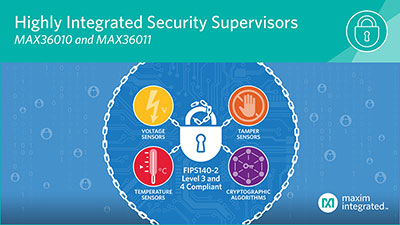 MAX36010 and MAX36011 security supervisors provide robust tamper detection and cryptography with 60 percent faster design cycle and 20 percent lower BOM costs
MAX36010 and MAX36011 security supervisors provide robust tamper detection and cryptography with 60 percent faster design cycle and 20 percent lower BOM costs
San Jose, CA—January 29, 2018—Designers of internet of things (IoT) devices now have a smarter and more secure way to protect stored, sensitive information with the highly integrated MAX36010 and MAX36011 single-chip security supervisors from Maxim Integrated Products, Inc. (NASDAQ: MXIM). These security solutions make it easier for designers to implement robust tamper detection, cryptography and secure storage while safeguarding sensitive information via logical and physical protections, without having to be security experts themselves.
- Details about MAX36010: www.maximintegrated.com/products/MAX36010
- Details about MAX36011: www.maximintegrated.com/products/MAX36011
The MAX36010 and MAX36011 both offer strong security that can be easily integrated into a design at any stage of its development. Additionally, if these parts are integrated later in the design cycle, there is no need to change the platform to accommodate them, thereby simplifying the implementation process. Compared to competitive solutions, the devices, due to their high level of integration, facilitate a 60 percent faster design cycle, while also lowering bill of materials (BOM) costs by 20 percent. To ensure a higher level of security, these supervisors generate keys via a true random number generator (TRNG). The keys are then stored in battery-backed RAM along with certificates and other sensitive data. This data is erased when tampering is detected, a capability that meets the requirements of Federal Information Processing Standard (FIPS) Publication 140-2 at its highest security levels (Levels 3 and 4).
The MAX36010 and MAX36011 both support symmetric and asymmetric cryptographic functions such as Data Encryption Standard (3DES), Advanced Encryption Standartd (AES), Rivest–Shamir–Adleman (RSA) and Elliptic Curve Digital Signature Algorithm (ECDSA). These secure cryptographic engines are designed and compliant to the requirements of Payment Card Industry (PCI) and FIPS140-2 certifications. The MAX36010 supports symmetric key generation for AES and 3DES, whereas the MAX36011 supports both symmetric and asymmetric key generations for AES, 3DES, RSA and ECDSA.
Key Advantages
- Highly integrated: Enables 60 percent faster design cycle and 20 percent lower BOM costs versus the closest competitive solution
- Includes temperature and voltage sensors, 1Kbyte of secure storage, dynamic tamper sensors, real-time clock (RTC), and TRNG—eliminating the need to use multiple discrete components
- Integrates multiple cryptographic functions including AES, DES, RSA, ECDSA and Secure Hash Algorithm (SHA) hardware engine
- Host interfaces include SPI, Universal Asynchronous Receiver/Transmitter (UART) and I2C; no firmware development is required to connect to the host processor
- Robust hardware security: Battery-backed RAM provides storage for sensitive information. Dynamic tamper sensors detect hacking incidents and immediately delete sensitive information
- Ultra-low power: Offers 70 percent lower battery current consumption compared to the closest competitive solution, which extends end product battery life
Commentary
- “IoT devices have now become commonplace in consumer households, which store personal and sensitive data related to the user’s day-to-day activities. While IoT designers have security top of mind, they are not always experts in this area,” said Stella Or, product definer for the Micros, Security & Software Group at Maxim Integrated. “Many of Maxim’s customers find that the MAX36010 and MAX36011 are both very easy to integrate in their design and most importantly, fulfil their security requirements, especially customers looking to design devices that meet the highest level of security and offer FIPS140-2 certification.”
- “The exponential growth of IoT devices will continue on its upward trend and is predicted to jump an average of 12 percent per year from 27.8 billion units in 2017 to over 135 billion units in 2030,” said Julian Watson, senior principal analyst IoT Connectivity at IHS Markit. “More IoT devices in the market mean that more of consumers’ personal data is at risk and designers of these devices need to be responsible for ensuring that the IoT ecosystem is genuinely safe and secure for users.”






